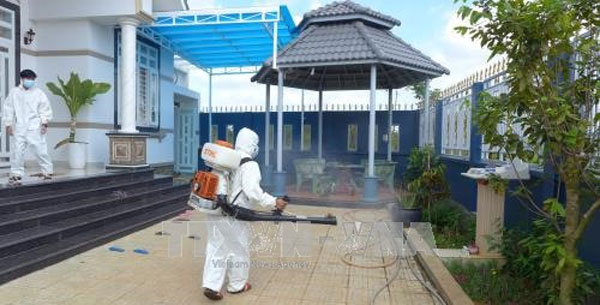[ad_1]
VietNamNet Bridge – The southern province of Binh Phuoc and several Central Highlands provinces are stepping up preventive measures as the number of malaria cases has risen since the beginning of the year, according to local centres for malariology-parasitology-entomology.
 |
|
A health official sprays chemicals in a resident’s house in Bình Phước Province. —VNA/VNS Photo
|
A report from the Centre for Malariology-Parasitology-Entomology in Gia Lai Province found that malaria has occurred in all districts, towns and its major city.
Nearly 400 patients have been diagnosed with malaria, an increase of 110 per cent compared to the same period last year. Of these, one had acute malaria in Duc Co District, but the patient recovered.
Dr Ro Mah Huan, the centre’s director, said that abnormal weather conditions had created favourable conditions for the development of mosquitoes.
The increase in malaria incidences is partly due to people sleeping without mosquito nets near mountainous or forested areas.
In la Pa District, 86 per cent of malaria cases have been men who were working in the forest or areas near mountains, Huan said.
Dr Truong Thanh Liem, vice director of Kong Pa District Health Centre, said the district’s number of incidences had increased by 91 since the beginning of the year compared to last year.
Many of the people infected had been looking for aloe wood in Dak Lak Province.
Hoang Hai Phuc, head of the Centre for Malariology-Parasitology-Entomology in Dak Lak Province, said that 187 patients with malaria were reported in the first seven months of the year, an increase of 76 patients compared to the same period last year.
Many of them were in the districts of Ea Kra, Ea Sup, Buon Don, Krong Nang, Ea H’Leo and others.
With the province seeing an upward trend of malaria incidences, it is facing difficulties in prevention and control, Phuc said.
To destroy mosquitoes that are vectors of transmission, spraying of chemicals should be carried out in April and September each year in the province, he said.
But the province’s health department has not budgeted for spraying, he said, adding that 600 litres of chemicals are needed.
Chemicals have been sprayed in Ea Kar District’s communes of Ea So and Ea Sar, which are hotspots for malaria.
The centre has received 100 additional litres from the Quy Nhon Institute for Malariology-Parasitology-Entomology in Binh Dinh Province for spraying in Ea Sup, Buon Don, Krong Nang, and Ea H’Leo where there are a high number of incidences.
More malaria cases are expected as rains continue, Phuc said, adding that if there are no chemicals, malaria will not be controlled.
The province’s health department has warned that local residents need to be more aware of preventive methods against the disease.
People staying in mountain fields or entering forests are advised to sleep on hammocks with mosquito net.
If they have a fever, they should go to the nearest health facility for timely treatment.
In Gia Lai Province, the Quy Nhon Institute for Malariology-Parasitology-Entomology plans to provide 280 litres of chemicals for spraying and for use on mosquito nets to protect 80,000 people in the province.
The Viet Nam Global Fund Malaria Control Project also will provide 15,000 mosquito nets and hammocks for people in communes with a high number of malaria cases.
The provincial People’s Committee has approved nearly VND600 million (US$25,700) for preventive methods in districts of Duc Co, la Grai, Kbang, Kong Chro, la Pa and Krong Pa.
The centre has set up many teams for disease surveillance and has worked with television stations to enhance communication.
Binh Phuoc Province has also stepped up preventive methods against many diseases, including malaria.
At least 973 patients with malaria have been reported in the first six months of the year in the province, an increase of 66.6 per cent against the same period last year.
Source: VNS
| related news |
[ad_2]
Source link
